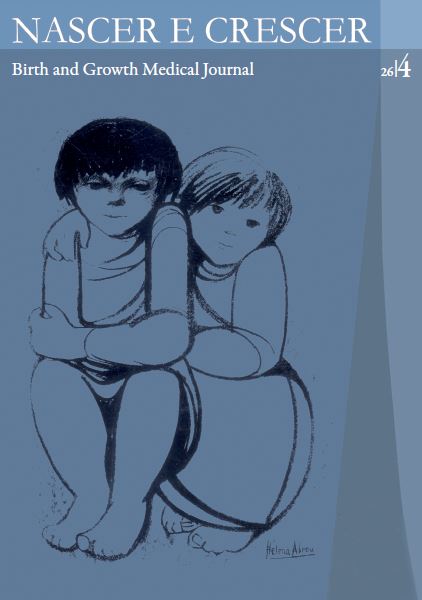Self medication in children and adolescents
DOI:
https://doi.org/10.25753/BirthGrowthMJ.v26.i4.10489Keywords:
Drug utilization, pediatrics, self medicationAbstract
Self-medication in children and adolescents consists in the administration of drugs to them by their parents or by themselves (in the case of older children and adolescents), without prior medical observation. National data on the prevalence and safety of this practice are scarce. This study aimed to assess the prevalence of self-medication in children, identifying the most used drugs and the main motivational factors for this practice. A cross-sectional, observational, descriptive and retrospective study was undertaken. Convenience sample was obtained from online and self-administered surveys to parents/caregivers of children and adolescents. 209 surveys were collected, containing data of children up to 17 years old (median 2 years old), without gender difference. Most participants (64%), reported having selfmedicated their children, 24% in the previous month. The notion that it would be a simple health problem and the recommendation of the same drug in a similar previous situation were the main motivational factors. Antipyretics were the most used drugs (paracetamol in 84,7% and ibuprofen in 53,1%), with a wide variability of the administered dosage. Antitussives / mucolytics, antiemetics and antidiarrheals were used by 26% of the sample. The adverse reactions that result from self-medication were reported in 1,4%. The prevalence of self-medication in this study was high, which is consistent with the international studies. The main used drugs are over-the-counter. This study highlights the high use of drugs without proven effectiveness or not recommended for children. The inadequate child’s dosage was one of the risk factors identified in the study, including some cases with potential toxicity. It’s necessary to inform the parents of the consequences of improper self medication and instruct them for responsible practice.
Downloads
References
The Role of the Pharmacist in Self-Care and Self-Medication. Report of the 4th WHO Consultative Group on the Role of the Pharmacist. Department of Essential Drugs and Other Medicines World Health Organization, 1998. http://apps.who.int/medicinedocs/en/d/Jwhozip32e/ acesso em Abril de 2014.
Soares M. Automedicação versus indicação farmacêutica. Mundo Farmacêutico 2005; 18: 27 citado em Joaquim MR. Automedicação versus indicação farmacêutica - Mestrado Integrado em Ciências Farmacêuticas. Faro: Faculdade de Ciências e Tecnologia, Departamento de Química e Farmácia Universidade do Algarve; 2011.
Maria VAJ. Automedicação, custos e saúde. Rev Port Clin Geral 2000; 16:11-4
Allotey P, Reidpath DD, Elisha D. “Social Medication” and the Control of Children: A Qualitative Study of Over-the-Counter Medication Among Australian Children. Pediatrics 2004; 11:e378-83. doi: 10.1542/peds.2004-0759
Simon HK, Weinkle DA. Over-the-counter Medications. Do Parents Give What They Intend to Give? Arch Pediatr Adolesc Med 1997, 151:654-6. doi:10.1001/archpedi.1997.02170440016003
Smith MBH, Feldman W. Over-the-counter Cold Medications A Critical Review of Clinical Trials Between 1950 and 1991. JAMA 1993, 269:2258-63. doi:10.1001/jama.1993.03500170088039.
Russell FM, Shann F, Curtis N, Mulholland K. Bulletin of the World Health Organization. 2003; 81:367-72.
Kogan MD, Pappas G, Yu SM, Kotelchuck M. Overthe-counter Medication Use Among US Preschoolage Children. JAMA 1994; 272:1025-30. doi:10.1001/jama.1994.03520130063034
Slack-Smith LM, Read AW, Stanley FJ. The use of medication in children attending childcare in Western Australia. J Paediatr Child Health 1998; 34:183-7.
Beckhauser GC, Souza JM, Valgas C, Piovezan AP, Galato D. Utilização de medicamentos na Pediatria: a prática de automedicação em crianças por seus responsáveis. Rev Paul Pediatr 2010; 28:262-8.
Pereira FSVT, Bucaretchi F, Stephan C, Cordeiro R. Selfmedication in children and adolescents. J Pediatr (Rio J) 2007; 83:453-8. doi 10.2223/JPED.1703
Maia R, Luís C, Moura M, Ribeiro R, Almeida H, Brito, MJ. Uso (ou abuso) de fármacos na idade pediátrica. Acta Pediatr Port 2011; 42:144-8.
Campos TA, Rebelo J, Águeda S, Rocha C, Lopes A, Ferreira S, et al. Medicamentos em idade pediátrica: informação precisa-se! Saúde infantil 2013; 35:138-42.
Joaquim MR. Automedicação versus indicação farmacêutica - Mestrado Integrado em Ciências Farmacêuticas. Faro: Faculdade de Ciências e Tecnologia, Departamento de Química e Farmácia Universidade do Algarve; 2011.
Taketomo CK, Hodding JH, Kraus DM,Pediatric and Neonatal Dosage Handbook. 2015. 22ª edição
Sullivan JE, Farrar HC, the Section on Clinical Pharmacology and Therapeutics and Committee on Drugs. Fever and Antipyretic Use in Children. Pediatrics 2011; 127: 580-7. doi:10.1542/peds.2010-3852
Goossens H, Ferech M, Stichele RV, Elseviers M. Outpatient antibiotic use in Europe and association with resistance: a cross-national database study. The Lancet 2005; 365: 579-87. doi:10.1016/S0140-6736(05)17907-0
Spellberg B, Guidos R, Gilbert D, Bradley J, Boucher HW, Scheld WM, et al. The Epidemic of Antibiotic-Resistant Infections: A Call to Action for the Medical Community from the Infectious Diseases Society of America. Clin Infect Dis 2008; 46:155-64. doi: 10.1086/524891
Downloads
Additional Files
Published
How to Cite
Issue
Section
License
Copyright and Authors' Rights
All articles published in Nascer e Crescer - Birth and Growth Medical Journal are Open Access and comply with the requirements of funding agencies or academic institutions. For use by third parties, Nascer e Crescer - Birth and Growth Medical Journal adheres to the terms of the Creative Commons License "Attribution - Non-Commercial Use (CC-BY-NC)".
It is the author's responsibility to obtain permission to reproduce figures, tables, etc. from other publications.
Authors must submit a Conflict of Interest statement and an Authorship Form with the submission of the article. An e-mail will be sent to the corresponding author confirming receipt of the manuscript.
Authors are permitted to make their articles available in repositories at their home institutions, provided that they always indicate where the articles were published and adhere to the terms of the Creative Commons license.


